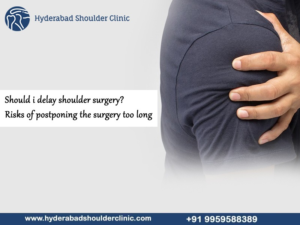After shoulder surgery, Shoulder Surgeon Hyderabad, Dr. Chandrashekar will give you some important advice to help you recover. The main aspect is to rest your shoulder and apply ice often to help with swelling and pain. He will prescribe pain management medication, which is a must, and avoid moving your shoulder too much. A sling is recommended to keep your shoulder stable. Follow the exercises along with a physical therapist.

Shoulder Surgeon Hyderabad, Dr. Chandrashekar’s advice: How to regain full shoulder mobility after surgery
Shoulder Surgeon Hyderabad, Dr. Chandrashekar’s advice to regain full shoulder mobility is as below. Surgery is a crucial part of the recovery process and requires a comprehensive approach involving professional guidance, specific exercises, and ongoing care. Here’s a detailed plan to help navigate this journey:
- Follow Post-Surgery Instructions:
– Adhere to Medical Advice: Start by carefully following your surgeon’s post-operative instructions regarding activity restrictions, medication, and wound care. Understand the timeline for recovery specific to your surgery type, as this varies for procedures such as rotator cuff repairs, shoulder replacements, or fusion surgeries.
- Engage in Physical Therapy:
– Schedule Regular Appointments: Work with a licensed physical therapist who specializes in orthopaedic rehabilitation. They can assess your shoulder’s current state and create a tailored rehabilitation program. Regular sessions (usually 1-3 times a week) are essential for monitoring progress.
- Start with Passive Range of Motion Exercises:
– Gentle Movements: Initially, you’ll likely begin with passive range of motion (PROM) exercises, where you may use your other hand, a stick, or a therapist’s assistance to move your arm without engaging the shoulder muscles. Examples include:
– Pendulum Swings: Lean forward and allow the affected arm to hang down, gently swinging it in small circles or back and forth.
– Assisted Arm Elevation: Lying on your back, use your non-injured arm to lift the injured arm overhead gently.

- Progress to Active Range of Motion Exercises:
– Gradual Engagement: As healing continues, your therapist will introduce active range of motion (AROM) exercises where you use your muscles to move your arm. Key exercises may include:
– Wall Walks: Stand facing a wall and “walk” your fingers up the wall, reaching higher as your mobility improves.
– Table Slides: Sit at a table, place your hand on a towel, and slide it forward to stretch the shoulder gently.
- Incorporate Strength-Building Exercises:
– Progressive Resistance: Once adequate range of motion is achieved, you’ll begin strengthening exercises. These should start with low resistance and progress gradually. Examples include:
– Resistance Band Exercises: Use bands to perform external rotations, internal rotations, and shoulder flexion, focusing on slow, controlled movements.
– Light Weight Lifting: If cleared by your therapist, incorporate light dumbbells for exercises like shoulder presses and lateral raises to build strength steadily.
- Utilize Ice and Heat Therapy:
– Monitor Pain and Inflammation: Apply ice packs for 15-20 minutes several times daily, especially after exercising, to reduce swelling and pain. Once inflammation decreases, consider using heat to relax muscles and improve blood flow, but ensure you do not use heat immediately after exercises.
- Practice Good Posture:
– Maintain Alignment: Focus on keeping your shoulders back and down, and your spine aligned. Good posture can alleviate additional stress on your shoulder and promote effective movement patterns. Ergonomic adjustments to your workspace and activities can also help.

- Be Patient and Consistent:
– Commit to Your Routine: Recovery is often a gradual process that varies from person to person. Stay consistent with your rehabilitation exercises, and try to practice them daily, as advised by your therapist, even when you start to feel better.
- Listen to Your Body:
– Recognize Pain Signals: Be mindful of any unusual pain or discomfort during exercises. If you experience sharp or debilitating pain, stop immediately and consult your therapist or doctor to prevent aggravating the injury.
- Stay Positive and Motivated:
– Engage in Enjoyable Activities: Keeping your spirits high can significantly affect your recovery. Set small, achievable goals to celebrate progress, and stay connected with supportive friends or a support group to share experiences and motivations throughout your journey.
Always communicate openly with – Shoulder Surgeon Hyderabad and Dr. Chandrashekar about your progress. He is best positioned to guide you based on your specific situation and ensure a safe and effective recovery to regain full shoulder mobility after surgery. If you have questions or would like additional support, don’t hesitate to reach out to us at https://hyderabadshoulderclinic.com/ or contact us at +91 9959588389 or shoulderandsportsclinic@gmail.com.





